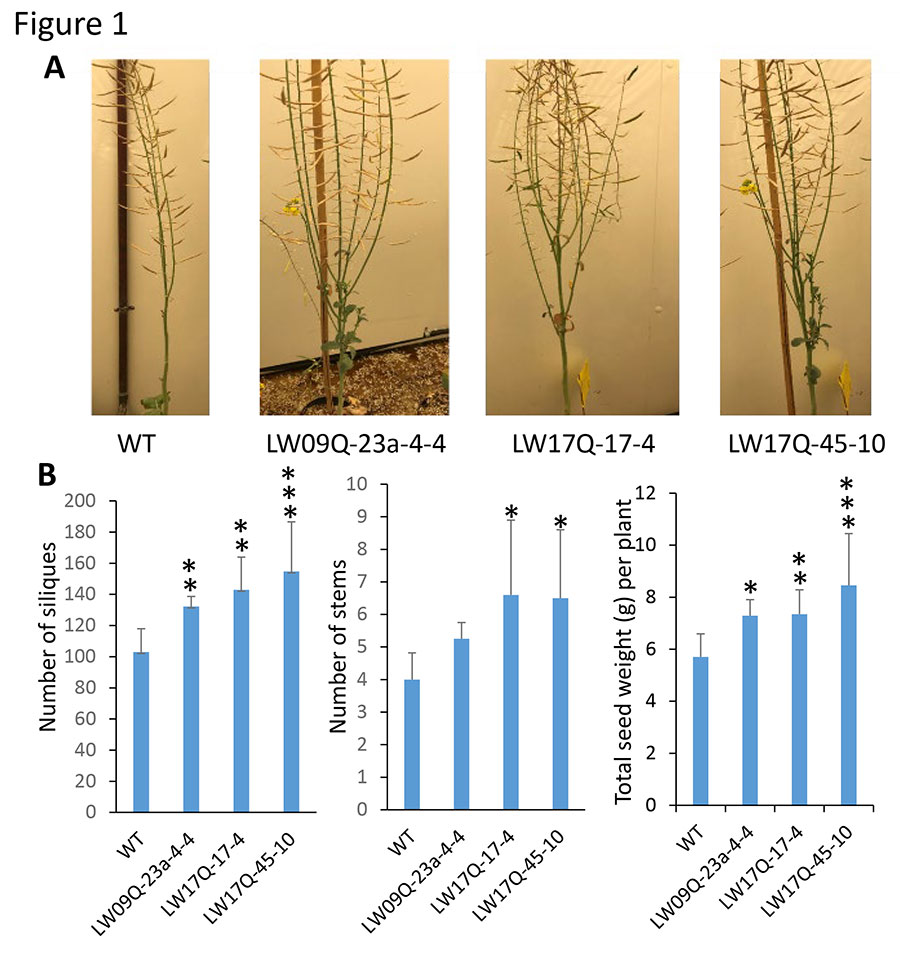Canola lines with corn genes yield more, have stronger stems
Key result:
CRISPR technology was used to generate a range of starch branching enzyme (SBE) mutants in canola. Sbe quadruple and sextuple mutants were used for expressing maize endosperm SBEI and effects on growth, morphology, flowering and yield determined. Introduction of corn SBEI into quadruple mutants (four canola genes edited) repeatedly led to increased total seed yield of 30 per cent in greenhouse conditions. In the sextuple sbe mutant an additional phenotype of a thicker stem conferred improved resistance to drought and high temperature. Additional lines are being generated to test under field conditions and a patent has been granted.
Project title, principal investigator:
“Enhancing yield and biomass in canola by modifying carbohydrate metabolism” Michael Emes, University of Guelph
Funding:
SaskCanola, Alberta Canola, Manitoba Canola Growers, Canadian Agricultural Partnership
Full report:
To find the full report and articles published in peer-reviewed journals, go to the Canola Research Hub at canolaresearch.ca and search for the project title.
Carbohydrates such as starch provide the stored energy reserves of plants. The research team previously developed a novel technology that caused a remarkable boost in seed yield in Arabidopsis by modifying starch metabolism. When the Arabidopsis endogenous leaf starch branching enzymes (SBEs) were replaced with corn SBEs, the Arabidopsis plants demonstrated significant increases in starch biosynthesis and a dramatic increase in seed production that led to a 250 per cent increase in total seed oil produced per plant. The increase in seed production was associated with an increase in the numbers of flowers and siliques per plant, while the fatty acid profile of the seed oil remained unaffected.
Canola (Brassica napus) is genetically close to Arabidopsis. This provided a feasible strategy to apply the above technology to canola. Canola has a more complicated genetic background and, since no SBE knockout mutants are so far publicly available, the strategy for replication of this effect in canola has been divided into two stages: (1) deletion of canola SBEs through gene editing and (2) expression of maize SBEs.

Effects on silique (pod) and stem numbers and total seed weight for canola lines over-expressing the corn starch-branching-enzyme (SBE) gene in the quadruple sbe mutant background. These are compared to the wild-type (WT) check. (A) The three transgenic lines and control line maintained in growth chambers (16h light, 21°C then 8h dark, 18°C). (B) Statistical analysis of the number of siliques, stems and total seed weight for each line. Values are means plus or minus standard deviation from five plants. Single, double and triple asterisks indicate the differences are significant at P<0.05, P<0.01 and P<0.001 (t-test).
Results
Using the CRISPR-Cas9 gene editing system, the researchers successfully produced homozygous mutant canola lines targeting all six SBE genes. They evaluated homozygous lines expressing the corn SBE in both quadruple and sextuple sbe mutants. The number of stems, flowers, and siliques were increased in the quadruple mutant expressing corn SBEI, yielding a highly statistically significant 30 per cent average increase in total seed weight per plant, compared to WT (Figure 1). Primary transformants expressing the corn SBE gene in the sbe sextuple mutant showed similar increases in productivity and are currently being taken through to homozygosity. Phenotypes of all the lines will be further evaluated in greenhouse and field.
While phenotyping the sbe sextuple mutant and WT plants, the research team noticed that at the maturation stage, the main stem in the sextuple mutant was 21-50 per cent thicker than WT when measuring the perimeter of internodes. Transgenic lines expressing corn SBEI in the sextuple mutant produce a similarly thickened stem as well as increased yield compared to WT, suggesting a double benefit from these genetic changes. The sbe sextuple genotype, possessing the thick stem, exhibited significantly improved tolerance to realistic exposure to drought and elevated temperature in controlled environment conditions.
Previous reports have shown that high temperature at flowering causes a deterioration in stem mechanical properties in canola, resulting in increased risk of crop lodging and accompanied yield loss. The research team will test whether the thickened stems can minimize yield loss under high temperature or drought stress in field conditions.
US patent 11,028,483 “Methods of increasing plant biomass and oilseed production” has been granted.





